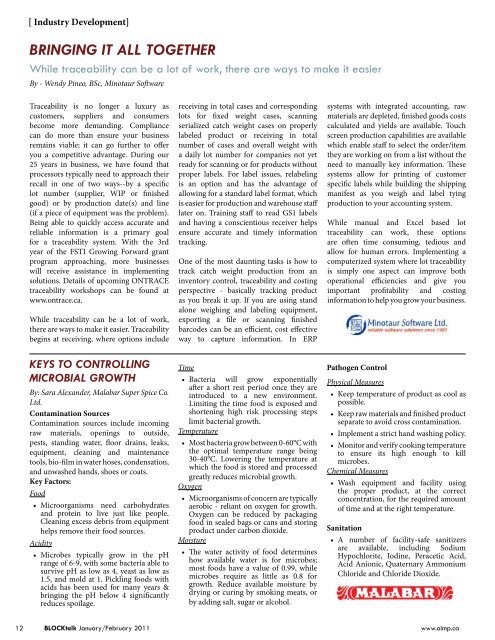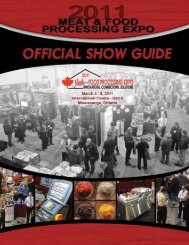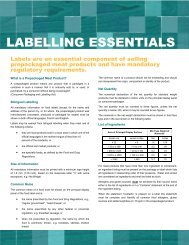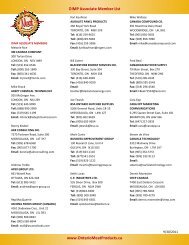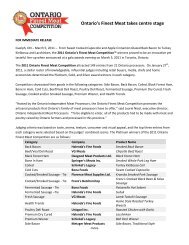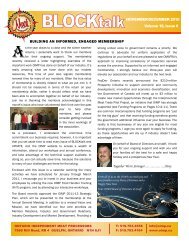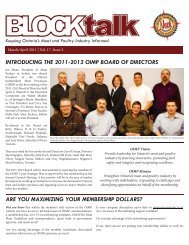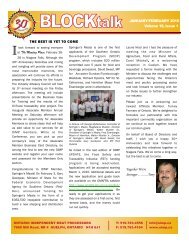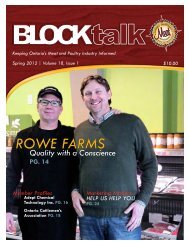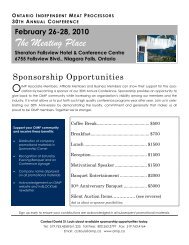record breaking numbers - Ontario Independent Meat Processors
record breaking numbers - Ontario Independent Meat Processors
record breaking numbers - Ontario Independent Meat Processors
Create successful ePaper yourself
Turn your PDF publications into a flip-book with our unique Google optimized e-Paper software.
[ Industry Development]<br />
BRINGING IT ALL TOGETHER<br />
While traceability can be a lot of work, there are ways to make it easier<br />
By - Wendy Pineo, BSc, Minotaur Software<br />
Traceability is no longer a luxury as<br />
customers, suppliers and consumers<br />
become more demanding. Compliance<br />
can do more than ensure your business<br />
remains viable; it can go further to offer<br />
you a competitive advantage. During our<br />
25 years in business, we have found that<br />
processors typically need to approach their<br />
recall in one of two ways--by a specific<br />
lot number (supplier, WIP or finished<br />
good) or by production date(s) and line<br />
(if a piece of equipment was the problem).<br />
Being able to quickly access accurate and<br />
reliable information is a primary goal<br />
for a traceability system. With the 3rd<br />
year of the FSTI Growing Forward grant<br />
program approaching, more businesses<br />
will receive assistance in implementing<br />
solutions. Details of upcoming ONTRACE<br />
traceability workshops can be found at<br />
www.ontrace.ca.<br />
While traceability can be a lot of work,<br />
there are ways to make it easier. Traceability<br />
begins at receiving, where options include<br />
KEYS TO CONTROLLING<br />
MICROBIAL GROWTH<br />
By: Sara Alexander, Malabar Super Spice Co.<br />
Ltd.<br />
Contamination Sources<br />
Contamination sources include incoming<br />
raw materials, openings to outside,<br />
pests, standing water, floor drains, leaks,<br />
equipment, cleaning and maintenance<br />
tools, bio-film in water hoses, condensation,<br />
and unwashed hands, shoes or coats.<br />
Key Factors:<br />
Food<br />
• Microorganisms need carbohydrates<br />
and protein to live just like people.<br />
Cleaning excess debris from equipment<br />
helps remove their food sources.<br />
Acidity<br />
• Microbes typically grow in the pH<br />
range of 6-9, with some bacteria able to<br />
survive pH as low as 4, yeast as low as<br />
1.5, and mold at 1. Pickling foods with<br />
acids has been used for many years &<br />
bringing the pH below 4 significantly<br />
reduces spoilage.<br />
12 BLOCKtalk January/February 2011<br />
receiving in total cases and corresponding<br />
lots for fixed weight cases, scanning<br />
serialized catch weight cases on properly<br />
labeled product or receiving in total<br />
number of cases and overall weight with<br />
a daily lot number for companies not yet<br />
ready for scanning or for products without<br />
proper labels. For label issues, relabeling<br />
is an option and has the advantage of<br />
allowing for a standard label format, which<br />
is easier for production and warehouse staff<br />
later on. Training staff to read GS1 labels<br />
and having a conscientious receiver helps<br />
ensure accurate and timely information<br />
tracking.<br />
One of the most daunting tasks is how to<br />
track catch weight production from an<br />
inventory control, traceability and costing<br />
perspective - basically tracking product<br />
as you break it up. If you are using stand<br />
alone weighing and labeling equipment,<br />
exporting a file or scanning finished<br />
barcodes can be an efficient, cost effective<br />
way to capture information. In ERP<br />
Time<br />
• Bacteria will grow exponentially<br />
after a short rest period once they are<br />
introduced to a new environment.<br />
Limiting the time food is exposed and<br />
shortening high risk processing steps<br />
limit bacterial growth.<br />
Temperature<br />
• Most bacteria grow between 0-60°C with<br />
the optimal temperature range being<br />
30-40°C. Lowering the temperature at<br />
which the food is stored and processed<br />
greatly reduces microbial growth.<br />
Oxygen<br />
• Microorganisms of concern are typically<br />
aerobic - reliant on oxygen for growth.<br />
Oxygen can be reduced by packaging<br />
food in sealed bags or cans and storing<br />
product under carbon dioxide.<br />
Moisture<br />
• The water activity of food determines<br />
how available water is for microbes;<br />
most foods have a value of 0.99, while<br />
microbes require as little as 0.8 for<br />
growth. Reduce available moisture by<br />
drying or curing by smoking meats, or<br />
by adding salt, sugar or alcohol.<br />
systems with integrated accounting, raw<br />
materials are depleted, finished goods costs<br />
calculated and yields are available. Touch<br />
screen production capabilities are available<br />
which enable staff to select the order/item<br />
they are working on from a list without the<br />
need to manually key information. These<br />
systems allow for printing of customer<br />
specific labels while building the shipping<br />
manifest as you weigh and label tying<br />
production to your accounting system.<br />
While manual and Excel based lot<br />
traceability can work, these options<br />
are often time consuming, tedious and<br />
allow for human errors. Implementing a<br />
computerized system where lot traceability<br />
is simply one aspect can improve both<br />
operational efficiencies and give you<br />
important profitability and costing<br />
information to help you grow your business.<br />
Pathogen Control<br />
Physical Measures<br />
• Keep temperature of product as cool as<br />
possible.<br />
• Keep raw materials and finished product<br />
separate to avoid cross contamination.<br />
• Implement a strict hand washing policy.<br />
• Monitor and verify cooking temperature<br />
to ensure its high enough to kill<br />
microbes.<br />
Chemical Measures<br />
• Wash equipment and facility using<br />
the proper product, at the correct<br />
concentration, for the required amount<br />
of time and at the right temperature.<br />
Sanitation<br />
• A number of facility-safe sanitizers<br />
are available, including Sodium<br />
Hypochlorite, Iodine, Peracetic Acid,<br />
Acid Anionic, Quaternary Ammonium<br />
Chloride and Chloride Dioxide.<br />
www.oimp.ca


